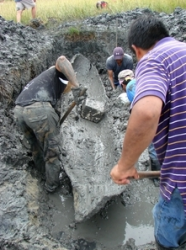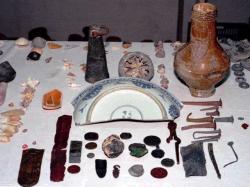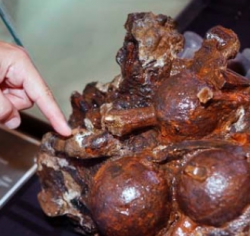INSTITUT SUPERIEUR D'ANTHROPOLOGIE
INSTITUTE OF ANTHROPOLOGY
ONLINE COURSES / COURS A DISTANCE
INSCRIPTION : Année Universitaire 2012/2013
REGISTRATION : Academic Year 2012 / 2013
USA –  Daufuskie Island - The dugout canoe, probably hand-hewn in the 18th century, was first found on Turtle Island in May. Daufuskie Island residents and University of South Carolina archaeologists, aided by natural erosion around the craft, were able to break the mud’s grip earlier this month. James Spirek, a USC underwater archaeologist, oversaw the dig and says the boat probably was hand-carved from a single log. By whom remains a mystery. “Based on how well this seems to be built, it suggests it was hewn with tools,” said Spirek, who helped raise the Confederate submarine H.L. Hunley from Charleston Harbor in 2000. It may have been “Indians using iron tools. I think more than likely it was ... European.” He hopes the canoe can one day undergo radiocarbon dating, which can determine its age within 50 years.
Daufuskie Island - The dugout canoe, probably hand-hewn in the 18th century, was first found on Turtle Island in May. Daufuskie Island residents and University of South Carolina archaeologists, aided by natural erosion around the craft, were able to break the mud’s grip earlier this month. James Spirek, a USC underwater archaeologist, oversaw the dig and says the boat probably was hand-carved from a single log. By whom remains a mystery. “Based on how well this seems to be built, it suggests it was hewn with tools,” said Spirek, who helped raise the Confederate submarine H.L. Hunley from Charleston Harbor in 2000. It may have been “Indians using iron tools. I think more than likely it was ... European.” He hopes the canoe can one day undergo radiocarbon dating, which can determine its age within 50 years.
http://www.postandcourier.com/article/20121021/PC16/121029879/1177/archaeologists-dig-up-ancient-canoe-off-daufuskie
FRANCE –  Bayonne - Les pelleteuses sont à l'œuvre, sur le site du Prissé, où le groupe Capio édifiera dans les prochains mois un imposant pôle de santé privé (1). Mais pour l'heu-re, les scientifiques de l'Inrap ont la possession des lieux. Sur 5 000 m2, ils charrient des tonnes de terre, sur les traces de nos ancêtres préhistoriques. L'archéologue David Colonge et son équipe décrivent un champ d'investigation « exceptionnel. Il est rare sur un même site, de mesurer une séquence de 200 000 ans aussi complète. » Ce retour vers le passé s'achèvera le 9 octobre. En deux mois, les enquêteurs de l'Inrap ont mis au jour environ 3 500 pièces. Majoritairement des éclats de silex et « matériaux pyrénéens ». Les archéologues ont les moyens de les faire parler. Leurs formes, tailles, les techniques qu'ils supposent, informent sur les époques ici ensevelies : « On sait que le plateau de Saint-Pierre-d'Irube où nous nous trouvons a été intensément habité par les hommes préhistoriques, de toutes les époques. Et sur ces fouilles apparaît une succession de quatre ou cinq grandes phases d'occupation. » Cela depuis 200 000 ans avant nous autres. « Nous sommes avec les prénéandertaliens. On ne sait pas bien qui ils sont. » Mais les scientifiques décryptent sans mal leurs techniques : « On parle aussi d'acheuléens. Ils font des outils plus lourds. C'est plus expéditif. Ils vont à l'essentiel, même s'ils sont capables de choses plus fines. » À la différence de l'homme de Néandertal à partir de moins 100 000 ans) dont la technique évolue au fil des siècles vers des hachereaux susceptible d'être emmanchés. « Ce sont surtout les derniers Néandertaliens. À partir de 35 000 ans, les Cro-Magnon ont des outils plus effilés, avec des armatures. » Nos si lointains aïeux, des chasseurs cueilleurs, vivaient en nomades. Ils se déplaçaient au gré du gibier. Des restes d'« habitat léger » trahissent aussi leur passage par la Prissé.
Bayonne - Les pelleteuses sont à l'œuvre, sur le site du Prissé, où le groupe Capio édifiera dans les prochains mois un imposant pôle de santé privé (1). Mais pour l'heu-re, les scientifiques de l'Inrap ont la possession des lieux. Sur 5 000 m2, ils charrient des tonnes de terre, sur les traces de nos ancêtres préhistoriques. L'archéologue David Colonge et son équipe décrivent un champ d'investigation « exceptionnel. Il est rare sur un même site, de mesurer une séquence de 200 000 ans aussi complète. » Ce retour vers le passé s'achèvera le 9 octobre. En deux mois, les enquêteurs de l'Inrap ont mis au jour environ 3 500 pièces. Majoritairement des éclats de silex et « matériaux pyrénéens ». Les archéologues ont les moyens de les faire parler. Leurs formes, tailles, les techniques qu'ils supposent, informent sur les époques ici ensevelies : « On sait que le plateau de Saint-Pierre-d'Irube où nous nous trouvons a été intensément habité par les hommes préhistoriques, de toutes les époques. Et sur ces fouilles apparaît une succession de quatre ou cinq grandes phases d'occupation. » Cela depuis 200 000 ans avant nous autres. « Nous sommes avec les prénéandertaliens. On ne sait pas bien qui ils sont. » Mais les scientifiques décryptent sans mal leurs techniques : « On parle aussi d'acheuléens. Ils font des outils plus lourds. C'est plus expéditif. Ils vont à l'essentiel, même s'ils sont capables de choses plus fines. » À la différence de l'homme de Néandertal à partir de moins 100 000 ans) dont la technique évolue au fil des siècles vers des hachereaux susceptible d'être emmanchés. « Ce sont surtout les derniers Néandertaliens. À partir de 35 000 ans, les Cro-Magnon ont des outils plus effilés, avec des armatures. » Nos si lointains aïeux, des chasseurs cueilleurs, vivaient en nomades. Ils se déplaçaient au gré du gibier. Des restes d'« habitat léger » trahissent aussi leur passage par la Prissé.
http://www.sudouest.fr/2012/10/22/200-000-ans-d-histoire-sous-la-future-clinique-857335-4018.php
PORTUGAL –  Portimão - A team of archaeologists are working to try and discover remains of a shipwreck from the Roman period, among other potential finds, in the Arade River in Portimão as part of an underwater archaeological campaign that started on Wednesday. Archaeologist Cristóvão Fonseca explained that the fieldwork, which is due to last two weeks, will comprise an initial phase of visual prospection and data recording with photographs and drawings, and the excavation of artefacts that may be found on the surface. It is believed one of the locations identified for prospection may have been the site of a shipwreck during Roman times, due to the discovery of a large concentration of ceramic vases called amphora, some still intact. Despite this, the theory may only be confirmed with excavations, which depending on the results obtained during the next two weeks could take place next year. Aside from that area, the archaeologists will dive in other sections of the river where the remains of five iron cannons and ammunition were found as well as bronze weapon artefacts from the 17th and 18th centuries. The study on the cannons and weapons, identified during the 1990s, point to a shipwreck in that area of a ship that may have sailed under the Spanish crown during the beginning of the 17th century. Another area to be explored appears to have the partially buried remains of a large wooden ship from the same time period.
Portimão - A team of archaeologists are working to try and discover remains of a shipwreck from the Roman period, among other potential finds, in the Arade River in Portimão as part of an underwater archaeological campaign that started on Wednesday. Archaeologist Cristóvão Fonseca explained that the fieldwork, which is due to last two weeks, will comprise an initial phase of visual prospection and data recording with photographs and drawings, and the excavation of artefacts that may be found on the surface. It is believed one of the locations identified for prospection may have been the site of a shipwreck during Roman times, due to the discovery of a large concentration of ceramic vases called amphora, some still intact. Despite this, the theory may only be confirmed with excavations, which depending on the results obtained during the next two weeks could take place next year. Aside from that area, the archaeologists will dive in other sections of the river where the remains of five iron cannons and ammunition were found as well as bronze weapon artefacts from the 17th and 18th centuries. The study on the cannons and weapons, identified during the 1990s, point to a shipwreck in that area of a ship that may have sailed under the Spanish crown during the beginning of the 17th century. Another area to be explored appears to have the partially buried remains of a large wooden ship from the same time period.
http://www.theportugalnews.com/news/archaeologists-work-to-uncover-shipwreck-remains-in-portimao/27026
BULGARIE –  Struma - A real archaeological treasure has popped out underneath the "Struma" highway construction works in western Bulgaria. The finds came from an unseen so far in size Thracian necropolis in the vicinity of the village of Dren, near the town of Radomir. They have been unearthed in the spring of 2012, after flooding in the area, but were kept secret in order to prevent their pillage from illegal treasure hunters. The unique necropolis dates from 7-8th century BC. It includes an area of 5 825 square meters, and is over 300-meter long. Bulgarian archaeologists are quoted saying it has no analogue worldwide and it belonged to local Thracian aristocrats since they were the only ones allowed to wear gold.
Struma - A real archaeological treasure has popped out underneath the "Struma" highway construction works in western Bulgaria. The finds came from an unseen so far in size Thracian necropolis in the vicinity of the village of Dren, near the town of Radomir. They have been unearthed in the spring of 2012, after flooding in the area, but were kept secret in order to prevent their pillage from illegal treasure hunters. The unique necropolis dates from 7-8th century BC. It includes an area of 5 825 square meters, and is over 300-meter long. Bulgarian archaeologists are quoted saying it has no analogue worldwide and it belonged to local Thracian aristocrats since they were the only ones allowed to wear gold.
http://www.novinite.com/view_news.php?id=144276
CANADA – Babine River - The department of Anthropology at the University of Northern British Columbia recently finished an excavation at a ancient fishing village on the Babine River. In 2010, the village was the focus of UNBC’s Archaeology Field School, which revealed that the settlement was at least 1,300 years old. As a result of those findings, the LBN invited the Department to conduct a more research-intensive excavation, funded by the LBN Treaty Office. In 2010 the village was a focus of the UNBC's Archaeology field school, revealing the village was at least 13-hundred years old. Due to the finding the LBN invited the Department to conduct more research. UNBC Anthropology Professor, Dr. Farid Rahemtulla says, “Probably one of the biggest village sites I've ever seen in the interior, quite remarkable because compared to our life today back in those days there are no big cities, so that would have been one of the biggest settlements I think in Northern BC...In terms of hunting weapons we found everything from things made from stone so anything from 1000 to a few thousand years old and also musket balls and flints for the old type of weapons, just around the time Europeans were arriving... and modern days cartage's, it was the entire garment of hunting weapons at least, and the same thin also goes for many other types of things that people do.”
http://www.cftktv.com/News/Story.aspx?ID=1794469
TURQUIE – Spradon - A rich history lies within the Ispartakule area of Istanbul’s Avcılar neighborhood, which has been riddled with treasure hunters for many years and is currently being eyed by Turkey’s Mass Housing Administration (TOKİ) as a desired location to build residences. Excavations carried out by archaeologists from the Istanbul Archaeology Museum have unearthed graves and objects from the 5th and 6th centuries. The museum defines the area as the ancient city of Spradon while TOKİ’s own experts have prepared a report claiming there is no ancient city in the area. TOKİ prepared its report in order to facilitate the exclusion of the Ispartakule area from archaeological site status. “It is known that there is an ancient city named Spradon [mentioned] in ancient documents but it has not become definite yet that remains unearthed in the area were from Spradon. It is also not known yet whether the Spradon settlement was a city or not. The traces [found in the Ispartakule] are most likely from a farm,” TOKİ’s report said.
http://www.hurriyetdailynews.com/ancient-city-of-spradon-waits-for-final-decision.aspx?pageID=238&nID=32801&NewsCatID=375
MALTE – Luther - Prior to construction, developers are sometimes required to conduct archaeological surveys to look for significant items. Seven years ago, Luther Forest Economic Development Corp. hired Hartgen Archaeological Associates of Rensselaer to study parts of Luther Forest targeted for construction of GlobalFoundries’ new computer chip plant. A team of six to eight people discovered evidence of late 18th-century dwellings, typical of the kind used by early local settlers. They also found broken ceramics, buttons, pewter spoons and coins, including a 1798 Liberty one-cent piece. “It reflects a pioneer lifestyle,” said Adam Luscier, Hartgen’s project director. The team used a variety of methods for evaluating Luther Forest property. They included everything from using metal detectors to excavating and sifting soil by hand. The group found evidence of structural remains, possibly a log cabin that would have been typical of that era. Such buildings were quite often very small. Settlers typically moved to a new area in the spring, which gave them time to build shelter and plant crops in preparation for the following year’s long winter, Luscier said. Foodstuffs were often kept in storage pits.
http://saratogian.com/articles/2012/10/21/news/doc5084a93db534f318574373.txt?viewmode=default
ROYAUME UNI – Chilton - The story of an Iron Age settlement that lies beneath an arable field is being pieced together in an archaeological dig. Land at Great Chilton, between Ferryhill and Chilton, in County Durham, is being excavated in a bid to discover more about the site’s past. The council decided to explore the site after aerial photographs revealed crop marks of several enclosures, which became clearer after geophysical surveys, and metal detecting found flints, Roman coins and medieval pottery. In the first of two weeks of exploration, the dig has already unearthed some interesting finds including pottery and a quern or millstone which shows grain was once processed on site. There is evidence of several enclosures, including roundhouses which could have been lived in or housed animals. County archaeologist, David Mason, believes the site could date back to 500BC and looks like a farmstead occupied by several generations.
http://www.thenorthernecho.co.uk/news/9997055.Dig_in_Chilton_discovers_Iron_Age_farmstead/
USA –  Beaufort - State underwater archaeologists wrap up the latest dive expedition at the Queen Anne’s Revenge shipwreck site next week but they’ll be back. With more than 34,000 artifacts — including 12 cannons, two anchors and 4,000 concretions containing smaller artifacts — still underwater and at risk of deterioration and ongoing state budget challenges, Carlisle said the department took on a fundraising project. To date, more than 50 percent of the artifacts have been recovered and the QAR will complete its latest trip to the site next week.
Beaufort - State underwater archaeologists wrap up the latest dive expedition at the Queen Anne’s Revenge shipwreck site next week but they’ll be back. With more than 34,000 artifacts — including 12 cannons, two anchors and 4,000 concretions containing smaller artifacts — still underwater and at risk of deterioration and ongoing state budget challenges, Carlisle said the department took on a fundraising project. To date, more than 50 percent of the artifacts have been recovered and the QAR will complete its latest trip to the site next week.
http://www.jdnews.com/news/local/qar-recovery-to-be-complete-by-2014-1.33180